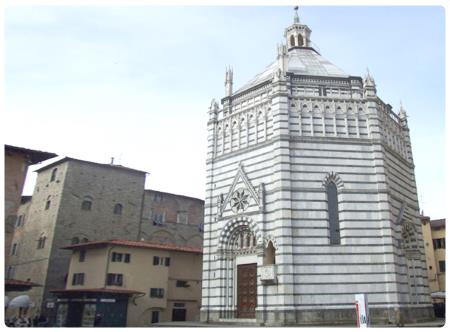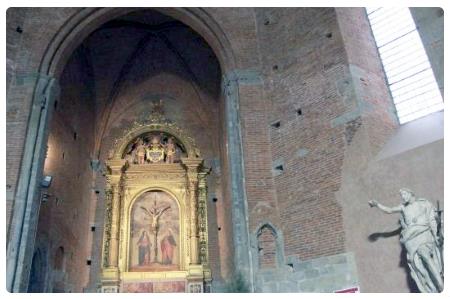|
You are here:
What to see in Pistoia
>
Baptistery of
San Giovanni in Pistoia
|
The
Baptistery of San Giovanni in Pistoia dates back
to the mid-14th century and stands on the area of
the ancient baptismal church of Santa Maria and San
Giovanni in Corte. The position opposite the
Cathedral of Pistoia is quite usual for this
type of church in the early Christian Romanesque
period. It was born in a period of high construction
experiences and can be considered an emblematic work
of Gothic Tuscan architecture. It is also one of the
last examples of a building designed to house
exclusively the baptismal font. In the fifteenth
century, in fact, the use of dedicating a particular
building to this ritual disappeared and the practice
of baptism by immersion was also lost. |
|
 The
baptistery was made by Cellino di Nese who would have performed, but
the news is doubtful, a project by Andrea Pisano. A small Gothic
jewel, characterized by the same architectural style recognizable in the
most famous twin building, the
Baptistery of
Piazza del Duomo in Florence.
Pistoia's collection of architectural elements not only Florentine, but also
Pisan and Sienese architecture, which is why the Pistoia Baptistery
is considered one of the greatest expressions of Tuscan Gothic
architecture. The
baptistery was made by Cellino di Nese who would have performed, but
the news is doubtful, a project by Andrea Pisano. A small Gothic
jewel, characterized by the same architectural style recognizable in the
most famous twin building, the
Baptistery of
Piazza del Duomo in Florence.
Pistoia's collection of architectural elements not only Florentine, but also
Pisan and Sienese architecture, which is why the Pistoia Baptistery
is considered one of the greatest expressions of Tuscan Gothic
architecture.
 Il nome è legato alla 'curtis
domini regis' longobarda, e cioè al centro politico e amministrativo
della città nel Medioevo e che in passato corrispondeva probabilmente alla
presenza di una Cappella Palatina, sulle cui fondamenta oggi poggia
l'attuale edificio. L'edificazione del Battistero è probabilmente avvenuta
nel XIII secolo nonostante venne poi completato dopo le guerre lucchesi e
fiorentine con Pistoia nella seconda metà del secolo successivo. Il nome è legato alla 'curtis
domini regis' longobarda, e cioè al centro politico e amministrativo
della città nel Medioevo e che in passato corrispondeva probabilmente alla
presenza di una Cappella Palatina, sulle cui fondamenta oggi poggia
l'attuale edificio. L'edificazione del Battistero è probabilmente avvenuta
nel XIII secolo nonostante venne poi completato dopo le guerre lucchesi e
fiorentine con Pistoia nella seconda metà del secolo successivo.
 The
name is related to the "curtis domini regis" longobard, that is to the
political and administrative center of the city in the Middle Ages and which
in the past probably corresponded to the presence of a Palatine Chapel,
on whose foundation the present building is today.The building of the
Baptistery probably took place in the thirteenth century despite it was then
completed after the Lucca and Florentine wars with Pistoia in the
second half of the next century. The
name is related to the "curtis domini regis" longobard, that is to the
political and administrative center of the city in the Middle Ages and which
in the past probably corresponded to the presence of a Palatine Chapel,
on whose foundation the present building is today.The building of the
Baptistery probably took place in the thirteenth century despite it was then
completed after the Lucca and Florentine wars with Pistoia in the
second half of the next century.
 In
the external cladding there is a new fact for the Pistoia churches in the
transition from Romanesque to Gothic, the unique use of white marble instead
of alternation with the green marble of Prato. Also on the outside, the
central door, by Pier Francesco Ventura da Pescia (1522), is a
masterpiece of the Renaissance carving. In the lunette above this portal
there are three statues, The Virgin and the Son between St. John the Baptist
and St. Peter, attributed to Tommaso and Nino, children of
Andrea Pisano. The balustrade that overlooks the main entrance, which shows
the image of Giovanni Battista sculpted, is linked to dramatic moments in
Pistoia's history. From here he preached to pacify during heated civil
clashes or to implore mercy in epidemics. In
the external cladding there is a new fact for the Pistoia churches in the
transition from Romanesque to Gothic, the unique use of white marble instead
of alternation with the green marble of Prato. Also on the outside, the
central door, by Pier Francesco Ventura da Pescia (1522), is a
masterpiece of the Renaissance carving. In the lunette above this portal
there are three statues, The Virgin and the Son between St. John the Baptist
and St. Peter, attributed to Tommaso and Nino, children of
Andrea Pisano. The balustrade that overlooks the main entrance, which shows
the image of Giovanni Battista sculpted, is linked to dramatic moments in
Pistoia's history. From here he preached to pacify during heated civil
clashes or to implore mercy in epidemics.
 The
baptismal font bears witness to the earliest origins of the building, it was
in fact built in 1226 by Lanfranco da Como, ratellastro di Guido (or
Guidetto), as can still be read today in the inscription in oncial
characters with date and signature of the artist who executed the work. The
current architecture of the workshop of Cellino di Nese, already
known for the works at the main monuments of Piazza dei Miracoli in
Pisa. The use of colored marbles that characterizes the entire
structure (typical white and green colours) is due to the Nese area, which
in turn is composed of three portals decorated with sculpted bas-reliefs. On
the top of the dome (shaped as a lantern) is a bronze sphere surmounted by a
cross. The building has been the object of a new recent restoration project,
concentrated in the consolidation and cleaning of the stone cladding of the
facades. Inside, in addition to the baptismal font, there is also a wooden
altar from the 16th century (previously present in the church of the Madonna
dell' Umiltà), an eighteenth-century statue depicting St. John the Baptist
by Andrea Vaccà. The
baptismal font bears witness to the earliest origins of the building, it was
in fact built in 1226 by Lanfranco da Como, ratellastro di Guido (or
Guidetto), as can still be read today in the inscription in oncial
characters with date and signature of the artist who executed the work. The
current architecture of the workshop of Cellino di Nese, already
known for the works at the main monuments of Piazza dei Miracoli in
Pisa. The use of colored marbles that characterizes the entire
structure (typical white and green colours) is due to the Nese area, which
in turn is composed of three portals decorated with sculpted bas-reliefs. On
the top of the dome (shaped as a lantern) is a bronze sphere surmounted by a
cross. The building has been the object of a new recent restoration project,
concentrated in the consolidation and cleaning of the stone cladding of the
facades. Inside, in addition to the baptismal font, there is also a wooden
altar from the 16th century (previously present in the church of the Madonna
dell' Umiltà), an eighteenth-century statue depicting St. John the Baptist
by Andrea Vaccà.
Works carried out in 1965 brought to light the original Romanesque
configuration of the baptismal font, hidden by the shape that had been given
to the structure in 1724 by Angelo Vaccà. The author was identified in
Lanfranco da Como, Guido's half-brother (or Guidetto), and the date of
completion was set at 1226.
Where is it located?
Top
Ostelli Pistoia
Ostelli Italia
Auberges de Jeunesse Italie
Carte de Pistoia
Karte von Pistoia
Mapa Pistoia
Map of Pistoia
Carte de la Toscane Karte von Toskana Mapa Toscana Map of Tuscany
Carte d'Italie
Karte von Italien Mapa Italia Map of Italy |